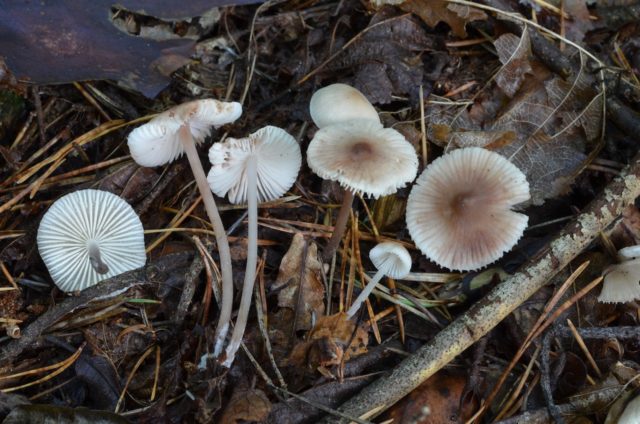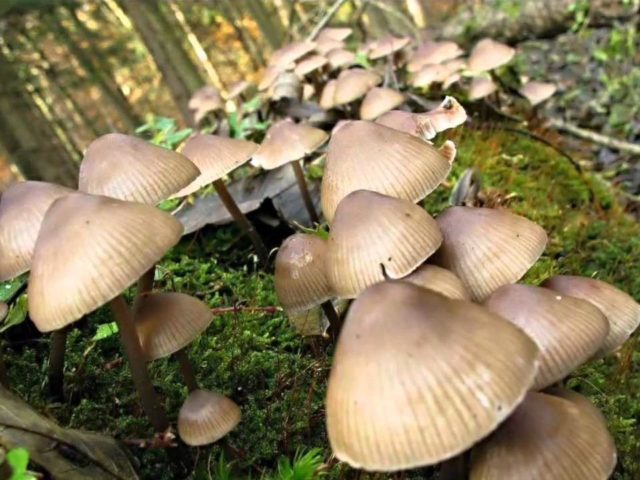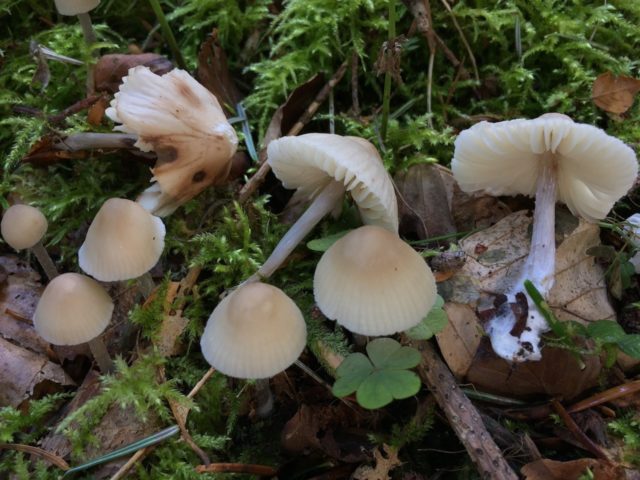Content
Mycena zephyrus (Mycena zephyrus) is a small lamellar mushroom, belongs to the Mycena family and the Mycene genus. It was first classified in 1818 and mistakenly attributed to the Agarik family. Its other names:
- marshmallow champignon;
- brown mycene widespread.

Small group of fruit bodies in a pine forest
What do mycenae marshmallows look like?
The caps of young mushrooms are bell-shaped, with a rounded-pointed top. Over the course of life, they take first an umbrella-shaped, and then a prostrate shape with a tubercle in the center. The edges of the caps are finely toothed, fringed, directed downward; in overgrown specimens, they are slightly curved upward, showing a fringe of the hymenophore.
The surface is glossy-dry, slimy after rain, satin-smooth. The skin is thin, the radial lines of the plates shine through. The color is uneven, the edges are noticeably lighter, white and cream, the center is darker, from beige and baked milk to chocolate-ocher. The diameter of the cap ranges from 0.6 to 4.5 cm.
The plates of the hymenophore have different lengths, wide, frequent. Slightly curved, not accrete, fringed edges. Snow-white, in old fruiting bodies darken to creamy beige, with uneven reddish-brown spots. The pulp is thin, easily breaks, white in color, with a characteristic rare odor.
The stem is thin and relatively long, fibrous, tubular, straight or slightly curved. The surface has longitudinal grooves, unevenly fringed, slightly damp. The pure white color darkens to an ash-purple at the root, in overgrown specimens it becomes burgundy-brown. The length varies from 1 to 7.5 cm with a diameter of 0.8-4 mm. Spores are colorless, glassy.

Mycena marshmallow - a miniature mushroom with a translucent, like a glass leg
Similar twins
Mycena marshmallow is very similar to some related species of mushrooms.
Mycena fagetorum. Inedible. Differs in a lighter, brownish-cream cap. Its leg also has a grayish-brown hue.

It settles mainly in beech forests, forming mycorrhiza only with this type of deciduous trees
Where do mycenae marshmallows grow?
The fungus is widespread throughout Russia and Europe, found in the Far East and Siberia. Mycena marshmallow prefers pine forests, and grows in mixed forests next to conifers. It can often be found in moss, where its slender stalk is quite long. It is not demanding for weather conditions and soil fertility.
The period of active fruiting is from September to November, and even longer in the southern regions. Forms mycorrhiza with pines, less often - juniper and fir. Grows in large and small groups.

Mycena marshmallow often hides among forest decay, in grass and moss.
Is it possible to eat mycenae marshmallows
It is classified as an inedible mushroom due to its low nutritional value, small size and unpleasant pulp odor. No toxicity data available.
Conclusion
Mycena marshmallow is an inedible lamellar mushroom belonging to the Mycene genus. You can see it everywhere in pine forests or mixed pine-deciduous forests. It grows from September to November. Inedible due to its thin flesh with a characteristic unpleasant aftertaste. Comprehensive scientific information about the substances that make up it is not in the public domain. Has inedible counterparts.








